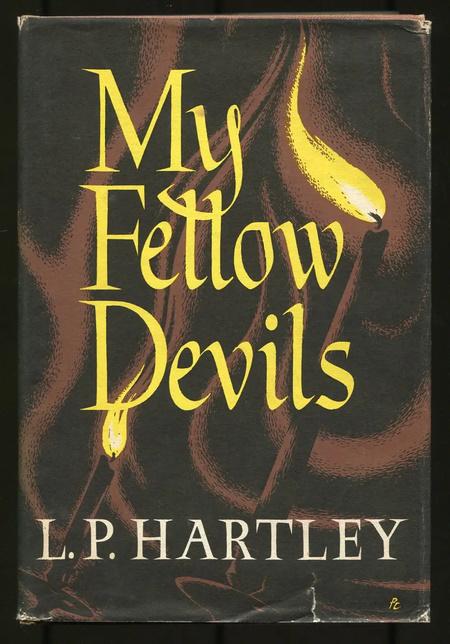Book review by George S: At twenty-eight years old, Margaret Pennyfather is a model upright citizen. Unmarried, she looks after her father, does much local charitable and committee work, and is the youngest person on the local bench of magistrates. In this role she has come across crime and wickedness, but sees it as a matter of practicalities:
On the Bench she reminded herself, she had had many cases of theft to deal with, and never had she felt the slightest touch of superstitious horror when the malefactor was brought before her. He was just a man, like other men; very often he was a child – a delinquent child, and it would be for her to help to decide whether or not he should be sent to an approved school.
This is a conservative novel of the 1950s, and meeting such an upright, rational and assured character in the first chapter, the seasoned reader will be aware that she is due for an encounter with Evil (with a capital E).

Friends who think Margaret’s life is missing out on fun invite her to the cinema, to see a gangster film, which she does not enjoy very much, but an acquaintance, Nick lets slip that he used to know the film’s raffish star, Calum McInnes. A relationship develops between Margaret and Nick, a barrister as responsible and serious as she is. All goes well, until, on a whim, she invites the film star to their engagement party, without telling Nick. Unexpectedly he comes, and Nick takes this very badly; the engagement is broken off.
Very soon, sensible Margaret is engaged to sexy Calum, a charismatic man, and as she only gradually discovers, deeply dishonest. He wants her to convert to Catholicism – but only for aesthetic reasons, so that their wedding could be more picturesque. After their marriage he lies and steals, but she continually makes allowances for him, and covers up his dishonesty. A crisis comes when a practical joke goes wrong and a woman dies.
Hartley very efficiently exposes Margaret’s thought patterns and her self-deceptions, as she continually makes excuses for her husband, and tries to conceal her knowledge of his wickedness even from herself. She is gradually corrupted, first by ignoring evidence, then covering it up, then lying about it. She visits a stern Catholic priest who lays out her duty – to leave him so that their yet unborn child will not be born into a family of deceit and lies. But she can’t do that.
The portrayal of Margaret is convincing – Calum’s less so. His role in the novel is a negative one; he is utterly untrustworthy, weak and dishonest. He is an actor, and the question is whether there are any times when he is not acting. The novel never lets the reader inside the character. Maybe that is because, having no principles, he is curiously empty; Hartley is using him to make a theological point, I think – that evil is a matter of emptiness -but Calum becomes an embodiment of this theory more than a character. And one suspects that L.P. Hartley knows less about the world of film stars than he knows about nice people who live in country towns.
Nick is, for most of the novel, nothing but a cipher, the respectable man from whom Calum steals Margaret. But (BIG SPOILER ALERT!) Nick is also the source of the novel’s biggest twist. We had been told from the start that Calum and Nick had been friends at school but that Nick now regards the idea of meeting him again with utter abhorrence.
When Calum is arrested and charged after the woman’s accidental death, Margaret turns to Nick and begs him to help Calum legally. He resists meeting Calum, but she insists. The charges are dropped – because of an alibi that is almost certainly fake – but Calum and Nick are suddenly close friends. The nineteen fifties were reticent, and L.P. Harley was a reticent novelist so it is never quite explicitly spelled out. Theirs is a homosexual relationship. It had begun at school, and now they are reunited, Nick’s self-control is down, and he is as much in love with Calum as Margaret had ever been.
As I say, we are told this only in hints, and I think there was a much better that Hartley could have been written with Nick as the protagonist. But this was 1951, when homosexuality could not be explicitly explored if you wanted to get your novel into Boots’ Library. L.P. Hartley was himself homosexual, but in this novel he can only present homosexuality as the ultimate sin, the ultimate dishonesty of Calum the shape-shifter, the fatal weakness of upright Nick, and not to be spoken of directly, only in whispers.
The opposite of Calum’s wickedness is the Roman Catholic church, represented here by an upright priest, who is the only person to see Calum’s character (and Margaret’s weakness) clearly. The novel ends with Margaret having ditched both Calum and Nick, and heading towards her first communion.
But she has a baby, who has exactly Calum’s wicked smile, and she is hugely in love with him, so maybe there is some ambiguity in the ending.
I quite enjoyed reading this novel, but it is very much a book of its time. It is a curiously unphysical book. Calum is supposed to be amazingly sexy, but the book shies away from showing his sexiness rather than just telling us about it. What happened on his honeymoon with Margaret? What did he and Nick actually get up to together? This is not a book that is going to tell us.
